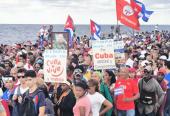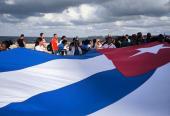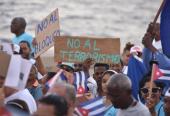May 20, 1902, or the False Independence
especiales

On May 20, 1902, the US interventionist authorities handed over power to the first Cuban president, Don Tomas Estrada Palma, in Havana. The proclamation of the Republic after 30 years of struggle for independence was celebrated in cities and towns across the country. Thousands of people gathered along Havana Bay and in front of the Palace of the Captains-General to watch the American flag being lowered and the lone star flag being raised there and at El Morro. Balloons bearing Cuban flags soared and wooden triumphal arches were erected across the country, with patriotic motifs or those related to friendship with the supposedly selfless northern neighbor, which had made the country's independence possible.
At the same time, the first photographic studios reproduced images of beautiful young women adorned with the Cuban flag, alongside an American soldier gallantly guarding it. The mainstream press of the time covered the event without sparing words of gratitude for the United States' intervention.
This was the prevailing popular ideology that hid the true interests of the nascent imperialism, which only succeeded after the fall in combat of José Martí and Antonio Maceo, key leaders who, with a clear anti-imperialist conscience, could guarantee the unity of the Cuban people to prevent annexationist strategies.
There were few patriots who recognized the true objectives of the false allies, described with great sincerity by one of the main actors in that plot, US Governor Leonardo Wood.
"Of course, Cuba has been left with little or no independence with the Platt Amendment, and the only thing indicated now is annexation (…) It’s quite evident that it’s absolutely in our hands (…) With control, which will undoubtedly soon become possession, we will soon practically control the world's sugar trade (…) The island will gradually become Americanized, and in due time, we will have one of the richest and most desirable possessions in the world."
Wood held plenty of reasons to be enthusiastic about establishing the world's first neocolonial system in the neighboring nation, already envisioned by the founders of the United States as the ripe fruit that would fall into their hands after breaking away from the Spanish colonial empire.
However, they waited patiently until 1898, when the Cubans, in their third war of independence, predicted Spain's certain defeat in a matter of time.
The timely and mysterious explosion of the battleship Maine in Havana Bay in early 1898 provided the final push for the intervention of US troops, who required the support of the Mambises for the landing of the Marines and operations on the eastern coasts.
To this end, the northerners addressed local military leaders such as Calixto García directly. This, in addition to facilitating their military operations, sowed potential discord among the pro-independence ranks, as there was no recognition, as a matter of principle, of the supreme command of the Liberation Army and the structures of the Republic in Arms.
After the Cubans' brave and decisive support for the triumph of the campaign, they prevented the Liberation Army and General Calixto García himself from entering Santiago de Cuba to participate in the Spanish surrender in 1898, under the pretext of possible Cuban revenge against the Spanish. This prompted a dignified response from the Cuban leader in a letter to General William Shafter, in which he strongly protested the affront.
The prominent Mambi leader wrote to the Yankee soldier: (…) “We are not a savage people who ignore the principles of civilized warfare; we form a poor and ragged army, as poor and ragged as the army of your ancestors in their noble war for the independence of the United States of America; but, like the heroes of Saratoga and Yorktown, we respect our cause too much to taint it with barbarism and cowardice.”
In Tomás Estrada Palma, American politicians had a servile collaborator. The future Cuban president had settled in the United States, where he dedicated himself to education. From his initial patriotic stances during the Ten Years' War, he gradually evolved toward his conviction that his compatriots were incapable of governing themselves without the tutelage of a great power, and he foresaw that annexation could be a solution for their future.
However, these considerations were not widely known, and he eventually replaced José Martí as head of the Revolutionary Cuban Party, which he dissolved after the war, closed his newspaper Patria, and was an important factor in the demobilization of the Liberation Army and the leadership bodies of the Revolution, among other services rendered to imperial purposes.
US administration also forced the Constituent Assembly charged with drafting the fundamental law of the Republic to include in its sections the Platt Amendment, drafted by a senator of the same name, which established that it banned the nation from entering into international treaties, created conditions for ceding the Isle of Pines to the United States, and required it to hand over bays for coal bases, among other conditions detrimental to national dignity.
Thus was born the republic that was considered a protectorate of the United States around the world, with the appearance of an independent territory due to its flag, an anthem, and a supposedly sovereign government.
It wasn't until January 1, 1959, that the definitive dismantling of more than 50 years of imperialist domination, promoted on that distant May 20, 1902, would begin.
Translated by Amilkal Labañino / Cubasi Translation Staff













Add new comment